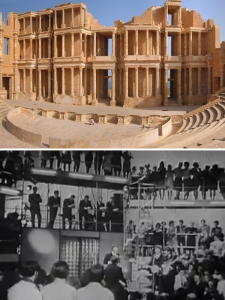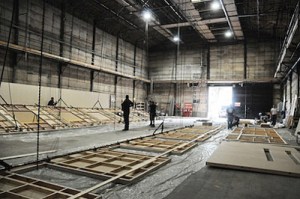It was 12 days until their scheduled concert, and on January 8, 1969, the Beatles were loose, relatively upbeat and open-minded, uncommon characterizations associated with Get Back/Let It Be sessions. Still, there wasn’t even consensus on what continent to stage the concert, much less what venue or what kind of audience would have tickets to the show.
What they lacked in plans and new material — Paul would insist the group would produce a few “rockers” soon — the Beatles at least had no shortage of live productions against which they could reflect and project.
Two classes of potential inspirations highlighted discussions to this point: recent live broadcasts by their peers (eg., Cream’s Farewell Concert, the Rolling Stones’ Rock and Roll Circus) and the Beatles’ own history on stage and on the small screen. The audience was as much a consideration as the venue.
In the final hours of the day’s sessions, as the group continued to work on George’s new song “I Me Mine,” John and Yoko waltzed the room right into a continued deliberation of the staging of the imminent show.
“I think the thing to do is just put you all in a framework, which will be just, like, the audience and a stage,” pitched Michael Lindsay-Hogg, who was tentatively willing to settle for a simple approach if his preferred idea — an overseas trip — was denied. “And by the time we get to the stage, we’d have a routine of numbers. We can find each number how they fit theatrically, like your dance for that one, like the song that you cry in and the song you do that brings tears to everybody’s eyes.” Off mic, it was joked there’ll be the one song that’s done in the wrong key.
“Seriously,” the director continued. “Almost, we should end with ‘Good Night’ or whatever song is going to be like ‘Good Night’ this time. … The end of the show should be a tearjerker like ‘Hey Jude’ or like ‘Good Night’ or like something else.”
Two large signs promoting the show’s working title — “January 20, 1969” — would hang as a backdrop. “And it’s the 19th of February, 1982,” John injected for a laugh and commentary on the decision process’ plodding pace.
When Paul asked about the composition of the audience, Michael answered forcibly, “Human beings, and the first thousand who queue up.” John was more specific, positing “pastry cooks from Walton-on-Thames” would be in attendance. (John’s joke was told nine weeks before the London suburb actually became a footnote in Beatles history: George and Pattie were fined for drug possession in Walton-on-Thames on March 12, 1969 — the same day Paul and Linda married.)
To snickers, Michael proposed voice overs for each song. E.g.: “Now Paul sings a song of true love.”
The audience seated at Twickenham’s Stage 1 would sit in the round, either at three-quarters or fully encircling the group. “You could build this place great like that, all of it like a coliseum,” Paul said. “Four sides, then on the top of it all, your cameras, or a camera.”
“I still don’t think that’s our best idea, for the record and on tape,” Michael replied, resigned. “But I think if that’s what we’re going to do, it’ll be fine. Because I’ll make it fine, and you’ll make it fine.”

Coliseums real (Sabratha, top) and fabricated (“Around the Beatles” at Rediffusion’s Wembley Park studio)
The bar for the Beatles’ triumphant return to the stage re-established at “fine,” Michael conceded “torch-lit is for next time.”
While the coliseum-style arrangement recalled to Michael the currently shelved Sabratha, Paul was reminded of a moment in the group’s history from four and a half years earlier, when Beatlemania was at its peak.
“It’s a bit like ‘Around the Beatles.'”
“Ah, I was thinking about that,” Michael said. “That was a very good show. That’s why I think it should be kind of theatrical. … Also the Presley show they’ve just done, apparently, which has more of an ‘Around the Beatles’ audience.”
In reality, the live sequences in the ’68 Comeback Special — broadcast on NBC as “Singer presents … Elvis” — had more of a “Hey Jude” vibe than an “Around The Beatles” one; there was always a distance between fans and the band in “Around the Beatles,” while “Hey Jude” and the Comeback Special put the musicians within reach of the crowd, and the King several times interacted directly with the commoners. What “Around the Beatles” and the Comeback Special did share in their audiences was its enthusiasm-cum-mania.
The Comeback Special was being cited in discussions of the Beatles ’69 show, but it had no influence on the “Hey Jude” taping, or vice versa. Elvis filmed the concert portion in late June 1968 but those tapes weren’t broadcast until December. “Hey Jude” was filmed in early September 1968 and broadcast days later. The two paths never crossed.

Way beyond compare: Around the Beatles (left), Elvis’ Comeback Special (center) and the “Hey Jude” promo film.
Elvis triumphantly rehabilitated his rock and roll credentials with his special; the Beatles didn’t need to do that. Yet …
“One of the things we’re up against,” Michael continued, “is all the past things you’ve done.”
Here we are with a reference to the past again. The Beatles did a lot. But surprisingly, although they were commonly featured across all facets of the media, they had very few their own television programs.
“There’s only about three of them,” Paul said, and John rattled off the list: “‘Magical Mystery Tour,’ ‘Around the Beatles’ and ‘Shea'” — the latter the landmark 1965 concert at the former New York Mets ballpark that was broadcast a year later on BBC and in 1967 in the U.S. on ABC. (It recently had a run in theaters in 2016, remastered and looking downright fab as the capper to the enjoyable “Eight Days a Week” documentary).
But “Magical Mystery Tour” was a scripted musical, and “Shea” was a concert film. So that means …
“‘Around the Beatles’ is our only ever TV show, isn’t it?” said Paul.
“And it was good,” Michael said, as Glyn Johns — who had long, but falsely claimed second-engineer duties on the show (see the postscript of this post for more on that) — called the program “fantastic.”
After John broke into a few seconds of “Shout” — the finale of that show — Paul complained to Michael about a theater-in-the-round setup, arguing it’s a step backward, replicating the set of “Around the Beatles.”
“I think with every idea we will have is bound to be … any of us can pick out a negative side to it,” Michael countered.
“Yeah,” Paul replied. “But it should’t be too heavy negative a side.”
Michael asked the others for input, but John replied by playing Chuck Berry‘s “Sweet Little Sixteen” — a song Michael said, without explanation, “always frightens me” — and swapping in a variety of British locales for the original American cities. (John delivered a more serious reworking of the song six years later on his Rock ‘N’ Roll album).
Returning to “I Me Mine,” Michael remarked John and Yoko’s waltz is “kind of theatrical. And it’s also romantic, and it also fits the song.” Michael was also concerned about the complete bill and “what’s going to be our mind-blasting topper at the end, which I think ought to be a weep-weep, myself. A bang or a cry.”
Paul leaned toward the bang, saying, “we intend to write a couple of rockers.” That worked for Michael — at the beginning, at least. “I think you should open exciting and end with the audience in tears.”
John launches into another Chuck Berry number, this time “Almost Grown,” and is soon joined by Paul. Pleased, Michael said, “That’s what January 20, 1969″ is all about.”
The documentary portion of the production returns to Michael’s forefront when he asks his crew if this performance is being filmed — don’t forget, while the Nagra tapes recorded sound throughout the sessions, the group wasn’t consistently filmed.
Despite the illusion, it was time to get back to work, and Paul returned to setting the agenda.
“Are we all right on George’s number (‘I Me Mine’)? I’m not. Are you? Should we keep doing it a bit more?”
And so, for the time being, the Beatles ended negotiations regarding the live show. The metaphors don’t come much easier: The Beatles’ recounting and considering a return to a theater in the round left them talking in circles.

